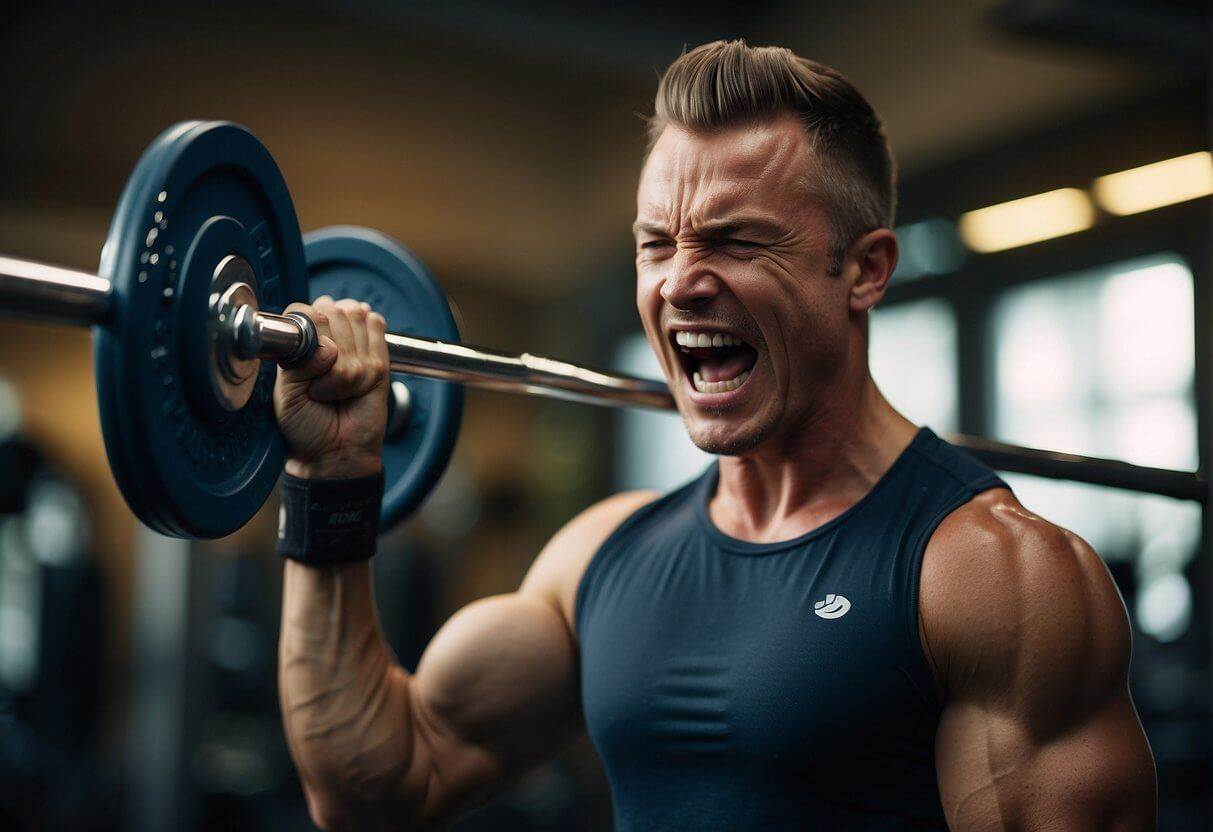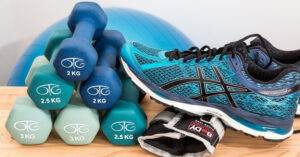Experiencing neck pain during bicep curls isn’t just uncomfortable; it can also be a sign that something about your technique needs tweaking.
It’s common to feel the strain in your neck when you’re working hard to lift weights, particularly during bicep curls. This pain can arise from a variety of factors, such as incorrect form, using weights that are too heavy, or simply not warming up properly.
It’s essential to listen to your body and understand why your neck might hurt to ensure your workouts are both effective and safe.
To avoid injury and discomfort, it’s crucial to perform bicep curls with proper form. When you start to fatigue, your body often tries to compensate by engaging other muscles to help complete the lift. This can include the muscles in your neck, which aren’t designed to handle this type of load.
Ensuring you’re using the right technique not only helps to prevent neck pain but also targets your biceps more effectively, leading to better muscle growth and strength gains in the long run.
Maintain a neutral spine and avoid arching your back or swinging the weights as you lift. Keeping your elbows tucked in at your sides can help stabilize your upper body and reduce the temptation to recruit your neck muscles, allowing your biceps to do the work they’re supposed to.
If neck pain persists, it might be a good idea to lower the weight or look into other underlying causes, such as muscle imbalances or a previous neck injury.
It’s always better to train smart and listen to your body, ensuring you can keep curling without the fallout of preventable injuries.
Understanding Bicep Curls
When you’re pumping iron to get those arms in top shape, knowing the nitty-gritty of bicep curls can make all the difference. We’re diving into the anatomy involved and the mechanics of the movement, so you can curl without the hurt.
Bicep Anatomy and Curl Mechanics
Your biceps are not just for show; they’re key players in bending your elbows and rotating your forearms. When you perform a bicep curl, these muscles contract, moving your forearm towards your shoulder. A proper curl involves a smooth motion, maintaining tension in the biceps throughout the lift.
Neutral position is crucial – that’s when your palms face each other. It keeps your joints happy and your biceps working hard. The biceps tendon, which attaches your muscle to the bone, should glide smoothly if your form is ace.
Common Mistakes in Bicep Curl Form
A big no-no in bicep curls is letting your elbows swing or shift forward. Your elbows should be like guards, staying put beside your body. If they’re all over the place, you’re inviting trouble in the form of less growth and more strain on your neck muscles.
Another culprit for neck woes? Hunching your shoulder blades or heaving the weight up with a swing. Keep your upper body still as a statue; let your biceps do the heavy lifting. Using momentum rather than muscle power not only cheats your biceps of growth but also puts unnecessary stress on your traps and neck, potentially leading to a headache.
Causes of Neck Pain During Bicep Curls
When you’re cranking out those bicep curls, you might feel a pesky neck pain sneaking in. It’s important to understand why this happens, so you can get back to training hard without discomfort.
Poor Exercise Form and Technique
Blasting through those curls without minding your proper form can lead to neck strain. It’s crucial to avoid common mistakes like jerking the weights or leaning your head forward. These missteps can overload your neck muscles and even cause neck pain and headaches.
Existing Muscle Weakness or Injury
If you’ve had a neck injury or shoulder pain before, odds are your muscles might not be ready to handle the stress of the workout, leading to discomfort. A previous condition like biceps tendonitis or muscle weakness can be aggravated by lifting weights, disrupting your range of motion.
Overuse and Muscle Fatigue
Doing too much, too soon, or too often can lead to fatigue and tendonitis. If your muscles are overworked, they cry out for a break. This means when you’re repeatedly pumping the iron without enough rest, you could be setting yourself up for neck pain and injury.
Prevention and Mitigation
Experiencing neck pain during bicep curls can be both uncomfortable and a sign you may be making some mistakes in your form or technique. But don’t you worry, there are several ways to prevent and address this common issue, ensuring your workouts remain effective and pain-free.
Correcting Form and Technique
Proper form is critical when performing bicep curls to avoid injury and neck strain. First, ensure your feet are shoulder-width apart to maintain balance. Keep your posture straight, with your shoulders back and down, away from your ears, which helps in involving only the necessary muscles. During the curl, your elbows should stay close to your torso, moving solely at the elbow joint. By focusing on elbow movement, you minimise the involvement of other muscles that can lead to neck pain.
Incorporating Rest and Recovery
Allow your muscles time to recover. Incorporating rest days into your workout routine gives your biceps, as well as supportive muscle groups such as the rotator cuff, a chance to repair after the strain of lifting. Overworking can lead to injury, so listen to your body and, if needed, conduct a physical exam to ensure you’re fit to train.
Using Proper Equipment
Selecting the right dumbbells or barbell for your strength level is vital to preventing neck pain. Using weights that are too heavy can cause you to compensate by using your neck muscles, which can lead to injury. On the flip side, weights that are too light may encourage poor form as you might perform the curls too quickly, increasing the risk of swinging the weights and again putting undue stress on your neck.
Always choose equipment and weights that allow you to execute each rep with controlled movement and perfect form.
Treating Neck Pain from Bicep Curls
If you’re feeling neck pain after performing bicep curls, it’s crucial to address both the immediate discomfort and to take steps to prevent this issue in the future.
Immediate Remedies
For immediate relief, you should apply an ice pack to your neck to reduce inflammation and swelling. Wrap it in a cloth to protect your skin and use it for 20 minutes every hour during the first day after the injury. A gentle stretch can also help: try tilting your head towards your shoulder and holding the position for 30 seconds. Over-the-counter anti-inflammatory medications like ibuprofen can alleviate pain and swelling, but it’s important to use them as directed and consult a healthcare professional if your pain is persistent.
Long-Term Strategies
To prevent future neck pain from bicep curls, ensure your exercise form is spot on—avoid swinging your arms and keep steady control to prevent overstraining your muscles. Gradually increasing weight to avoid fatigue and muscle strain is key. If tendonitis is a concern, building up your neck and shoulder muscles through specific exercises or yoga can be beneficial.
Always warm up with dynamic exercises before starting your workout to prepare your muscles for the strain. Should your neck pain not improve with rest and self-care, it’s essential to consult with a medical professional as you may need more specialised treatment or surgery to correct the underlying issue.
Additional Considerations

When embarking on a fitness journey that includes bicep curls, it’s important to stay attentive to your body’s responses. You might sometimes encounter complications such as a sore neck or headaches, which could be indicative of underlying issues in your technique or the weight you’re using.
When to Seek Professional Advice
If you’re experiencing persistent pain or discomfort following your workout, it’s crucial to consider getting professional advice. This is particularly true if your symptoms include swelling, stiffness in the neck, or a radiating pain that can suggest nerve irritation. A personal trainer or a physiotherapist can assess your movement patterns and technique to ensure you are not setting yourself up for a long-term injury.
Exercise Variations and Alternatives
Should bicep curls be causing undue stress on your neck, think about trying different exercise variations. Substituting with hammer curls or concentration curls can shift the stress and potentially alleviate the strain on your neck. Alternatives like resistance bands or cables offer a different range of motion and may be kinder to your joints. Remember, it’s essential to warm up properly and select a weight that allows you to maintain proper technique without straining. It’s better to lift lighter and right, than heavier and risk a rotator cuff or bicep tendonitis injury which could bench you from activities you love, like tennis or any sport that requires upper body strength.
Conclusion
Experiencing neck pain during or after performing bicep curls is a sign that something isn’t quite right with your technique. It’s crucial for you to focus on form. Your biceps should do the heavy lifting without other muscles, such as those in your neck, jumping in to compensate.
Remember, when you’re lifting, keep your neck relaxed. Stiffening up or straining can lead to discomfort. Think about maintaining a neutral spine —that means your head is in line with your torso, not jutting forward or craning upwards.
If you’re feeling sore, it might be a hint that you’re overloading. It’s tempting to shoot for those impressive weights, but your muscles need to build up strength gradually. Start with a weight that allows you to keep perfect form throughout. Increase gradually.
Sometimes, fatigue talks louder than we’d like, leading to a breakdown in form. It’s essential to listen to your body. When you’re tiring out, it’s better to take a short break than to power through with poor form and risk hurting your neck.
A spotter or trainer can be invaluable—they watch your form and provide feedback. Proper breathing helps too; don’t hold your breath, as it can increase tension in your neck.
Incorporating neck strengthening exercises into your routine can help as well. A strong neck is less prone to injury.
Lastly, if pain persists, don’t shrug it off. See a healthcare professional. They can pinpoint the issue and help you get back to lifting without the unnecessary pain. Taking care of your neck now means you can keep getting stronger, for longer.







